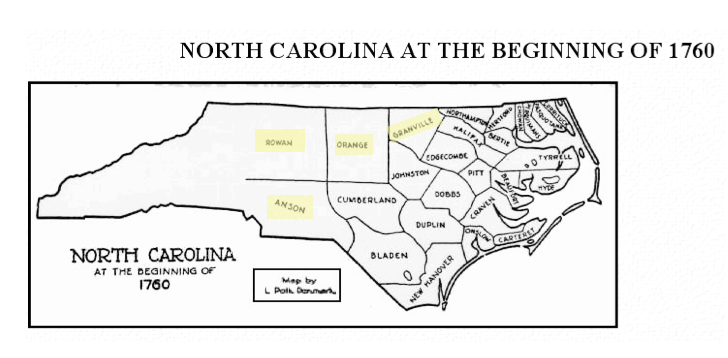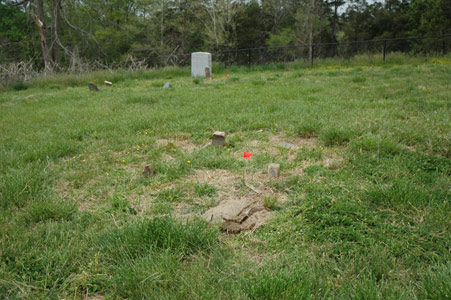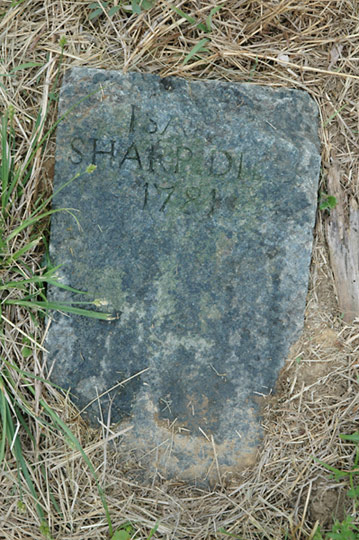Menu Items




![]()
Generation 9
Generation 1 |
Generation 2 |
Generation 3 |
Generation 4 |
Generation 5 |
Generation 6 |
Generation 7 |
Undisclosed |
Undisclosed |
Undisclosed |
Terry Donnell Sharpe |
Julius Henry Sharpe |
Henry Albright Sharp |
William Sharp |
Generation 8 |
Generation 9 |
Sebastian Sharp |
Isaac Sharp Jr. #193 |
Generation 1 |
Generation 2 |
Generation 3 |
Generation 4 |
Generation 5 |
Generation 6 |
Generation 7 |
Undisclosed |
Undisclosed |
Undisclosed |
Terry Donnell Sharpe |
Mary Elizabeth Donnell |
Sarah P. Albright |
Sarah Albright |
Generation 8 |
Generation 9 |
Elizabeth Sharp |
Isaac Sharp Jr. #223 |
193/223. Isaac Sharp Jr. (Married Maria Philopena (Philipena) Graves (#194/224) about 1765; around 1761-1766, possibly in or near Lancaster Co, Pennsylvania or Orange Co., North Carolina. [Source for the gray information is research done by Michael Cavenaugh (Glass family genealogist denoted on the Guilford County Genealogy Association Website)Source of information in fucia is p. 21 Marlatt, William P. and Kimberley C., “Tracing the Ancestry of William Henry Adair Bynun (1828-1866) – Unveiling the paternal Lineage (Self-published by the authors,Moorpark, California, 28 August 2024), Copy available from bmarlatt@aol.com.
Born: 1740 in Germany, 1740 probably in Lancaster Co., Pennsylvania. of Isaac Sharpe Sr. (#385/445) & Margarette A, Webber (#386/446). [Note: Isaac Jr. must not have been born in Germany because his father (Isaac Sharp Sr. #385/445) arrived in Philadelphia in 1738 aboard the Queen Elizabeth from Germany. There is no record that Isaac Sr. ever returned to Germany prior to Isaac Jr.'s birth in 1740.] Source of information in fucia is p. 21 Marlatt, William P. and Kimberley C., “Tracing the Ancestry of William Henry Adair Bynun (1828-1866) – Unveiling the paternal Lineage (Self-published by the authors,Moorpark, California, 28 August 2024), Copy available from bmarlatt@aol.com.
Died: 1781 (after 27 June 1781) 1782 in or near Orange Co., North Carolina.(The source of this blue information is his tombstone as shown below). He is buried in Orange County (now Alamance), North Carolina at Old Stoners Church Cemetery. [Note: Isaac Sharp Jr. was only 41 years old when he died. His cause of death is unknown.] Source of information in fucia is p. 21 Marlatt, William P. and Kimberley C., “Tracing the Ancestry of William Henry Adair Bynun (1828-1866) – Unveiling the paternal Lineage (Self-published by the authors,
Moorpark, California, 28 August 2024), Copy available from bmarlatt@aol.com.
[His siblings included:a) Henry (Honus) (Heinrich) Sharp, Sr: (Married: Barbara (Barbary) (Barbary Graves) Born: 1735 (circa 1735) in Germany. Died: 1814 c 1814 in Harrison Twp, Preble County, Ohio; Miscellaneous:, "According to History of Preble Co., OH, 1881, Henry Sharp was a native of Scotland but lived in Germany before coming to America. He and Barbara lived in Orange Co., NC before 1785, and probably moved to Botetourt Co., VA about 1782. He apparently left Virginia for Tennessee in 1789 and moved to Preble Co., OH in 1805, where he lived in 1814. Henry Sharp made deeds to his sons called love deeds in Bold Valley in Claiborne County. Henry, Sr., deeded land to five of his sons (the other sons were minor at this time, it seems). To Henry, he deeded 200 acres in Claiborne County; to Daniel, 277 acres in Claiborne County on the waters of Lost Creek; and similar amounts to Conrad, Jacob, and George, in the surrounding community. Henry Sharp, b. in Germany c 1735, son of Isaac & Margaret Sharp. Isaac was b. 1712 and d. Mar. 8, 1783 in Lancaster (now Lebanon Co.) PA. He was tax collector for Hannover Twp. in 1756. This region suffered greatly during the French & Indian War, and many of the first settlers left the area. Henry and his brother, John, were made executors of their father's estate on Apr. 8, 1784, at which time Henry and his wife were apparently living in Montgomery Co., VA. The Potts Manuscripts, Vol. IX, Tulpehocken Accounts for 1744 list George, Ernst and Samuel Scherb (Sharp) as well as Johannes and Andreas Graff (Graves). About 1792 the Sharp, Graves, Gibbs, Snodderly and related families settled at Sharp's Station in what is now Union County, TN. This site is in Big Ridge State Park on the east shore of Norris Lake. Henry was a brother to John, Aaron and George Sharp and Mrs. Nicholas Countz (WCG)....Sometime prior to 1785 he lived in Orange Co.,NC, as is indicated by a record stating that on June 3, 1785 , Henry and Barbara Sharp of Botetourt Co., VA, deeded to one Michael Holt land situated in Orange Co., NC. Henry's name appears on tax lists for Orange Co. for 1799 on property valued at $1480 and in 1780, 81 & 82 he was taxed on 225 acres of land in Orange Co. As his name does not appear on the tax lists after 1782, it is probable that he left Orange Co. about this time for Virginia."In the Brief of Deeds of Montgomery Co., VA, Nov. 2,1795, appears this entry: 'Henry Sharp and wife, Barbara, to George Williams, 112 acres on Sinking Creek.' At this time Henry was a resident of Knox Co., TN. Tax records seem to indicate that he left Virginia for Tennessee in 1789. He is believed to have moved from Tennessee to Preble Co., Ohio, in 1805, where he died in 1814.The first death in the township was that of Henry Sharpe, a native of Scotland. After spending a great part of his life in Germany, he came to Ohio and died in Harrison township about 1814. He was buried in the Euphemia graveyard, and is said to be the first man buried on the spot now covered with tombstones." 2 Note: Euphemia was on the National Road, which was constructed by the Federal government starting in 1811 from Cumberland, MD, to Vandalia, IL, at a cost of over seven million dollars. Today Euphemia is in the NW corner of Lewisburg, on the west side of SR 503. The cemetery is also called Roselawn. Henry served with Count Pulaski's Light Dragoons during the American Revolution. His name during the time in the military was "Henry Shaup".---- June third 1785 Henry and Wife Barbary in Botetort Co, Virginia made an a land deal listed as follows: This indenture made theis 3rd day of June in the 9th year of the American Independence and in the year of our Lord 1785 between Henry Sharp and Barbary his wife, Botetor and in the Province of Virginia of the one part and Michael Holt of Orance Coutnty in the Province of North Carolina inconsideration of the sum of 175 pounds proclamation...a certain tractor parcel of land situate...in the county of Orange on the waters of Haw River Grate Allemance beginning at a hickorrysaplin on…” [Source: of turquoise is "My Hutchcraft/Henderson Fernley Family Notes" posted on rootsweb.]
b) John Aaron Sharp: Born: about 1736 of Palatinate, German , Died:?; Miscellaneous: John and his brother Henry, were made executors of their father's estate on Apr. 8, 1784.
c) Margaret Sharp: (Married: George Pritz) Born:~1736. Died: before 1820 Miscellaneous: She died before her husband in 1820 and is not mentioned in his will.
d) Veronica Sharp: (Married: Jacob Setter) ; Born: 1738 Died: ?
e) Barbara Sharp (Married: Valentine Kintzer) Born: ? Died: ?;
f) Rebecca Sharp: Born:1744 Died:1816 in Kentucky;
g) John Joseph Sharp: (Married: Phyllis (Philopeni?) Efland) Born: 1753 in Orange County (Now Alamance), North Carolina. Died: 20 January 1830 in Anderson County, Tennessee
h) George Sharp: (Married:); Born: ? Died: ?)
i) Aaron Sharp: (Married:); Born: ? Died: ?)] ( Source of green: Know Your Relatives The Sharps by Genevieve E. Peters 1972) (Source in Purple: Find a Grave) (Source of orange WikiTree)
Miscellaneous: Isaac was the first Sharp in Alamance County, North Carolina. The Sharp family was of German stock from the region of the Rhine. The German spelling was Scharf .[Note: Alamance County formed in 1849 from western Orange County.]John Sharp's 2025 research (sent via e-mail to the webmaster) points out that North Carolina Land Grants 19: 449-455 state that George Sharp and Aaron Sharp bought land in Orange County NC from Henry McCulloh in 1763. Actually, George, Aaron and Henry, are included in a list of 156 names of those who purchased land in McCulloh’s Tract 11, most of which lay in Orange County. The list is arranged in chronological order from 20 Sep 1757 (George Clapp) to 28 Jun 1763 (George Coble, Jr). Fifteen of these sales took place between 1757 and 1761. The great majority of sales were in 1762 and 1763. Henry’s 216-acre purchase was recorded on 8 Oct 1762, the penultimate sale before the winter break. The 1763 sales began in May. George purchased 214 acres on 13 May. The scribe left off the year, but judging from George’s position in the list it was obviously 1763. Many, perhaps most, of the Sharp neighbors and in-laws bought property in these two years: Martin Loy, Malachy Hatmaker, Conrod Stoner, Frederick Moser, and Ludowick Albright are just a few examples. Aaron purchased 266 acres on 1 Jun 1763". [Note: Isaac had brothers named George, Henry, and Aaron.] As John Sharp documented in Records of the Superior Court of Justice held in Salisbury on 22 Sep 1763, p. 598, "Germans migrating to North Carolina were often naturalized in local courts like the Superior Court at Salisbury. They would generally take an oath of allegiance and sometimes a religious test before receiving citizenship. The Salisbury Court records contain several lists of 'natives of Germany [who were] Naturalized according to Law by taking the Oaths…' The 22 Sep 1763 document contains names that also appear on the McCulloh list: George Coble, Adam Moser, George Valentine Clap, and Malachiah Fogleman. Another list from March 1763 contains the names John Graves, Peter Noe, Anthony Cobble, George Fogleman, Lodowick Clap, and Lodowick Albright. A list from Mar 1764 with eight names includes Thomas Rich. On 22 Sep 1764 twelve natives of Germany '…with property certificates…' were naturalized: Martin Loye, Conrod Stoner, George Sharpe, Henry Sharpe, Jacob Summers, Adam Smith, and others. That George and Henry traveled together to be naturalized surely indicates they were very closely related." [Note: Martin Loy/Loye, Ludowick/Lodowick Albright, and John Graves are all direct ancestors of the webmaster.]
As quoted from Genevieve Peter's book: "The writer has been told that the Sharps who settled in and around Sharps Chapel were in Lancaster County, Pennsylvania, before going to North Carolina, but she has been unable to find records that would prove this theory. However, it is very likely that they were in Pennsylvania, since many of the families that settled in St. Asaph's District, Orange County, N. C. with the Sharps, namely - the Graves (Graffs) Loys, A1brights, Fousts, Snotherlys, and Nlcholas Gibbs are known to have come from Berks and Lancaster Counties, as well as other counties in the State.
From about 1725 to 1775 there was a great migration of Germans from the Palatinate into the State of Pennsylvania through the Port of Philadelphia. These immigrants soon became noted for their thrift, shrewdness, and industry, and were referred to as "Pennsy1vania Dutch." Being land-conscious, and attracted by the bright pictures painted by agents representing the interests of large landholders in North Carolina, many of these German immigrants made the hazardous trip from Pennsylvania to North Carolina and bought land in the western part of the state in that section known as the "Piedmont."
The Pennsylvania "Dutch" who settled in the Alamance" stopped on the fertile banks of the Great Alamance, Haw River, and Stinking Quarter Creek. Because they spoke only German, these people seldom held public office, but they made good soldiers when the Indians rose up against them, and were staunch defenders of their settlements against these attacks.
The early settlements were far removed from the seaports on the eastern coast, and because of this and the lack of transportation facilities, the settlers were obliged to become self-sufficing. Most of them were expert carpenters, coopers, and ironworkers, which accomplishments stood them in good stead in the making of their house furnishings and the building of their homes of logs cut from trees which had to be felled by their own efforts.
The scarcity of food (and no stores) made it imperative that every man become a hunter and fisherman, which probably explains why so many of our ancestors settled on the banks of a stream in what was very often a veritable wilderness.
The lives of the women must have been drab and colorless; their days filled with toil and hardships, due to the lack of conveniences, frequent child-bearing, and the ever-present fear of Indian attacks. Most of the materials that went into their clothes had·to be grown and then spun and woven into cloth, and this was done with the most primitive of implements. The women and girls wore long, full skirts made of linsey woolsey, with tops that resembled dressing sacks, or dresses and bonnets made of calico, and they often went barefooted during the summer months.
There were few schools, churches, ministers or doctors in these isolated settlements during the early days. In some of the communities, school masters taught those children whose parents could afford to pay for this privilege and they often received room and board in the homes of their pupils in lieu of money.
The settlers were burdened with heavy taxes under the British rule, which allowed corrupt officers - clerks, tax gatherers and lawyers - to levy huge taxes and demand large fees from the settlers, with no hope of redress. The charge for a marriage license was so tremendous that many of the inhabitants, unable to pay the fee demanded took each other "for better or for worse" and considered themselves married. It was because of these corrupt practices that in 1764, a band of settlers, who had previously organized, calling themselves Regulators, attempted to correct these outrages.
As quoted from Genevieve Peter's book from "History of the Alamance" by Sally Stockard in 1900: "All historians are violently partisan to one side or the other. Some regard the Regulators as bandits. Others are equally positive that the Regulators were engaged in a great social and political crusade. The Regulators had many and real grievances beyond a doubt".
"It was in 1764 that these people first began to make themselves heard. The up-country section, beyond the unsettled pine barrens, where the struggle took place, was more democratic than any other part of the American colonies, excepting possibly Vermont. Their grievances became intolerable in 1760. Repeated petitions to the government for redress proved futile, so they formed what would be called today a union. They met in an assembly to regulate their grievances and thus won for themselves the name Regulator. In the beginning they did not wish to use force or violence. They wished only to have a public meeting with their officials to discuss the matter of exploitation and extortion, that is, the habit of the county officials of levying higher taxes and collecting greater fees than the laws actually specified."
"At that time in North Carolina taxes on land were the same everywhere in the province. The tax levy was 75 cents on every 100 acres of land. There was no regard for improvements, location, or value. In the interior, because of the insurmountable difficulties of bad roads, and lack of transportation, the people could use their surplus crops only in barter trades with their neighbors and nearest stores. These trades brought in no cash because there was no money minted in the American colonies. There was no way to secure any large amount of cash except through export trade. Thus when taxes, payable in cash, were levied, the people had property but no money, and were unable to get it. They could not pay their taxes. Their property was sold and they were ruined."
"These were the grievances of the Regulators: 1. County officers were charging higher fees and levying higher taxes than the law specified. 2. A tax to pay the debts of the province was still being levied although more than enough to pay it had already been collected. 3. The government taxed the people but provided no specie to pay taxes."
"Four counties were engaged in the War of the Regulation. They were Anson, Granville, Orange and Rowan. War broke out in 1768 in Rowan, which comprised a great part of the western section of the province." [Note: at that time Isaac was likely living in western Orange County.]
Isaac and his wife had seven children: Sebastian (Boston) (Bostian) (#97) , Philipena (Philopena), John, Peter, Christian, Elizabeth "Betsy" (#112), and Isaac III. (The source of the purple is information from John Sharpe via e-mails and a phone conversation. [Susan Snyder, webmaster of this genealogical study is the direct descendant of two of their children, Sebastian and Elizabeth].
Below: The" Will of Archives" is dated June 27, 1781 and was probated 6 February 1782 . At the time the will was written, Isaac Jr. has 2 older sons, two minor sons, two minor daughters, and his wife is expecting another child. That child will be Isaac III, born after Isaac II's death.
Below is a copy of Isaac's will. [Note: Isaac did not actually write his will. He left his mark with an "X".
Below is a transcription of the above will. [Note: the original 1781 Will was very difficult to read and the transcriber apologizes for errors]
On April 18, 2006 Norman Sharpe (Great Great Great Great Grandson), Helen Leach (#4) (Great Great Great Great Granddaughter) and Sandra Henson, Mary Lue Finch, and Susan Snyder (#2)... all Great Great Great Great Great Granddaughters.... visited Stoners Church Cemetery located in a pasture, at that time on Rufus J. Dale's farm, in Alamance County on Bellemont-Kimesville Rd. near the village of Belmont (near Graham) just off highway 49. After probing the ground where the red flag is located in the picture below, Isaacs tombstone was located. For orientation to its location, the large stone at the top of the hill is that of John Noe.
The stone reads:
"Isaac
Sharp Died
1781"
Below is a stone that was located next to Isaac's stone in 2021 by James Andrews and John Sharp. It reads "SHARPS INPHANT 1741". This could not be one of Isaac Jr's children if the date is correct. Isaac was not born until 1740. Could this have been one of Isaac Jr's siblings? This is yet another puzzle for those of us studying the Sharp family.
Lifetime Events Summary for Isaac Sharp Jr.:
Contact person for this website is Susan Snyder: susanleachsnyder@gmail.com






